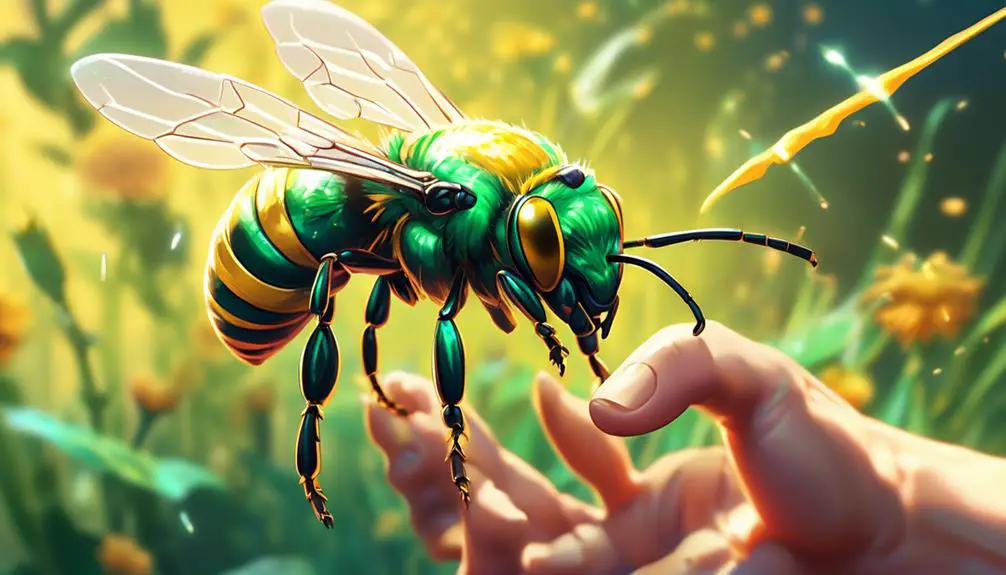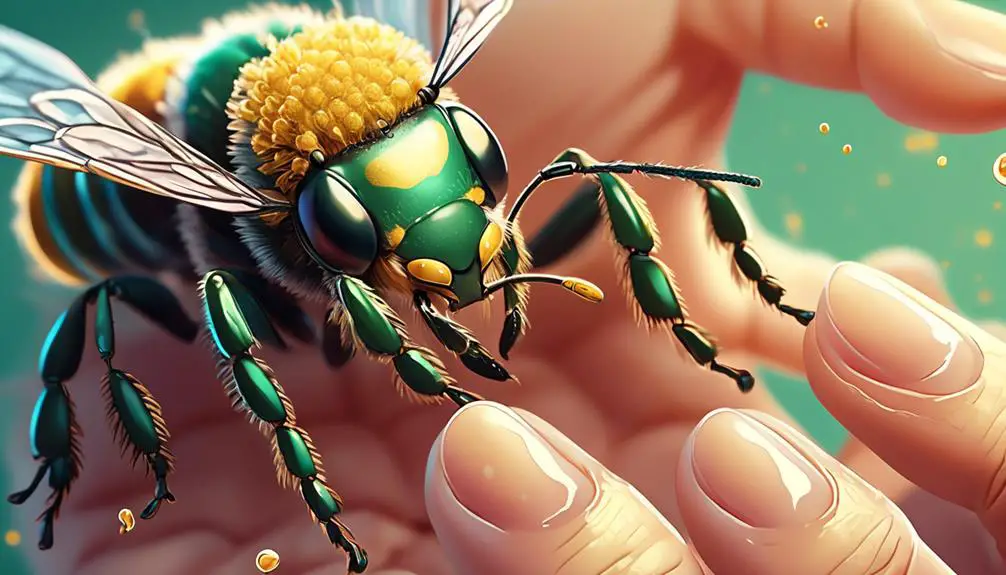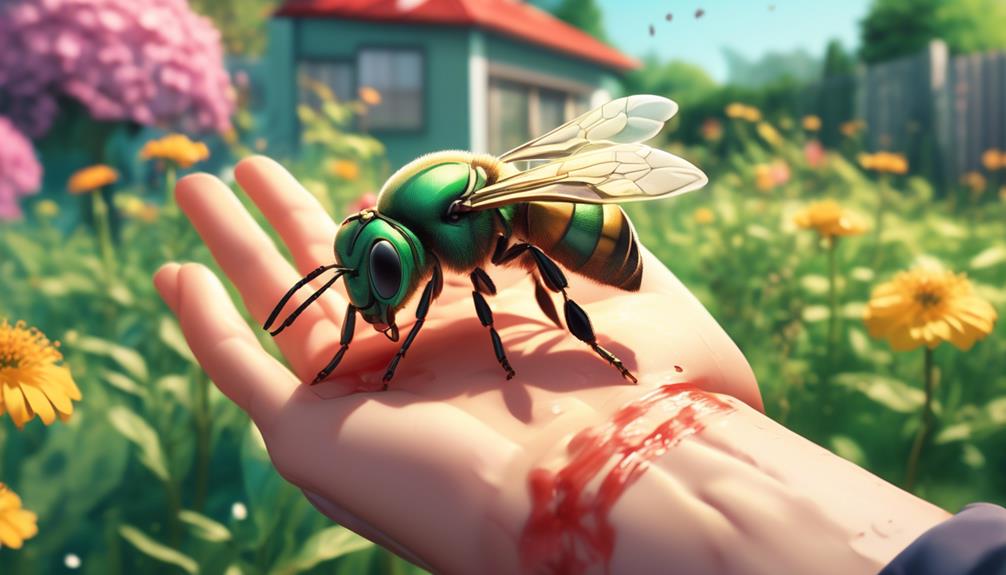Glimpse into the intriguing world of sweat bees and discover if their sting can strike more than once.

Can a Sweat Bee Sting More Than Once
Just as you've experienced the lingering heat of a jalapeno pepper long after the first bite, you might wonder if the tiny sweat bee can deliver a sting that continues to pack a punch.
You're probably familiar with the common narrative of honey bees dying after one sting, but is the same true for their smaller, less aggressive cousins?
This seemingly simple question unravels a complex world of insect biology and behavior, offering surprising insights that challenge many of our assumptions.
So, let's dive into the buzz and sort out the facts from the myths.
Key Takeaways
- Sweat bees are attracted to human sweat for necessary salts.
- Female sweat bees can sting, while males are harmless.
- Sweat bees can sting multiple times if they feel threatened.
- Sweat bee stings are less painful than other bee stings.
Understanding Sweat Bee Behavior

How do sweat bees behave and why are they attracted to humans in the first place?
Sweat bees are fascinating creatures. They're not aggressive by nature, but they're attracted to human sweat, which is why you'll often find them buzzing around you on a hot day. Your sweat provides them with the salts they need to thrive.
They're solitary insects, unlike their honeybee counterparts, which means they don't have a hive to protect. This makes them less likely to sting unless provoked. If you've been stung by one, it's probably because you've accidentally disturbed it or made it feel threatened.
The females are the ones capable of stinging, while the males are harmless. The sting, however, is mild and less painful compared to other bee stings. Interestingly, sweat bees have a unique behavior of burrowing into the ground to nest, especially in areas with unobstructed sunlight.
Understanding sweat bee behavior helps you coexist with them. Remember, they're not out to harm you. They're just busy doing their job in the ecosystem—pollinating plants. So, the next time you cross paths with a sweat bee, don't panic. Instead, appreciate its role in maintaining biodiversity.
The Anatomy of a Sweat Bee Sting

While appreciating the role of sweat bees in our ecosystem, it's also crucial to understand what happens when a sweat bee stings you. Like other bees, sweat bees have a stinger, a specialized organ used primarily for defense. However, they differ in one key aspect: they can sting multiple times.
Their stinger is connected to a venom sac that contracts when the bee stings, releasing venom into the victim. Unlike honey bees, sweat bees' stingers are smooth and don't get stuck, enabling multiple stings.
Here's a table to visually break down the anatomy of a sweat bee sting:
Part | Function | Comparison to Honey Bees |
|---|---|---|
Stinger | Injects venom | Longer, but thinner |
Venom Sac | Stores venom | Smaller, less potent venom |
Barb | Helps stinger penetrate skin | Smooth, allows for multiple stings |
This anatomy is a survival mechanism for the delicate sweat bee. Their venom isn't as potent as other bees, but they make up for it with their ability to sting repeatedly. So, while sweat bee stings aren't typically as painful, their persistent nature can be a real nuisance if provoked.
Frequency of Sweat Bee Stings

Despite their tiny size, sweat bees shouldn't be underestimated, as they're capable of stinging multiple times when they feel threatened. Unlike honey bees, which die after one sting, sweat bees aren't limited by a barbed stinger. This allows them to sting repeatedly if they perceive a threat.
However, let's dive deeper into the frequency of these stings. You might assume that being around sweat bees means you're likely to get stung frequently. But it's important to know that these bees aren't naturally aggressive. They're relatively docile and only sting when provoked. If you're calm and don't swat at them, you're less likely to be stung.
The likelihood of being stung also depends on the species of sweat bee. Some are solitary, while others live in colonies. Solitary sweat bees tend to sting less often as they've less territory to protect. On the other hand, colonial sweat bees can be more defensive and hence, might sting more frequently.
Dealing With a Sweat Bee Sting

Should you find yourself on the receiving end of a sweat bee sting, it's crucial to know the correct steps to alleviate the discomfort and prevent possible complications.
Sweat bee stings are generally less painful than those from other bees, but they can still cause discomfort and irritation.
Firstly, remove the stinger if it's still in the skin. Do this carefully to avoid squeezing more venom into the wound.
Secondly, clean the area with soap and warm water. This will help prevent infection. Apply a cold pack to reduce swelling and numb the pain. Over-the-counter pain relievers can also help.
Should you experience severe reactions like difficulty breathing, dizziness, or swelling of the face, lips, or throat, seek immediate medical attention. This could be a sign of a severe allergic reaction known as anaphylaxis.
Don't scratch the sting area, as this can increase the risk of infection. If the area becomes red, swollen, or hot to touch over a few days, consult a healthcare professional as it may be infected.
Prevention Measures Against Sweat Bees

After understanding how to deal with a sweat bee sting, it's just as important to explore how you can avoid these stings in the first place. Prevention is always better than cure, and sweat bees are no different.
One of the most effective ways to avoid attracting sweat bees is by controlling your scent. Bees are attracted to strong smells, so limiting the use of perfumes or scented lotions can help keep them at bay.
Another preventive measure is to wear appropriate clothing. Light-colored garments are less appealing to these bees than dark ones.
A clean and tidy environment is also a key deterrent for sweat bees. They are attracted to garbage and decaying organic matter, so regular cleaning can discourage their presence.
Here's a concise table detailing these preventive measures:
Prevention Measures | Description | Effectiveness |
|---|---|---|
Control Scent | Limit use of perfumes and scented lotions | High |
Appropriate Clothing | Wear light-colored garments | Moderate |
Clean Environment | Regular cleaning, especially of organic waste | High |
Conclusion
In conclusion, you're not likely to get stung by a sweat bee unless you provoke it. Despite being able to sting multiple times, they're generally harmless. However, if you do get stung, promptly clean the area and monitor for signs of allergic reactions.
It's advisable to take preventive measures to ward off sweat bees, such as avoiding wearing bright colors and floral perfumes. Understanding their behavior and anatomy can help you live harmoniously with these often misunderstood creatures.


